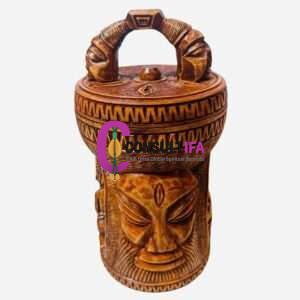The term “Laroye” has recently captured the public’s imagination, particularly following its mention by notable figures such as Paolla Oliveira, sparking a renewed interest in its origins and meaning. However, this word is far more than a transient cultural reference; it holds deep roots in the rich tapestry of Afro-Brazilian religious practices.
Central to this spiritual lexicon, “Laroye” is intimately tied to the veneration of Eshu, an Orisha (deity) revered in religions like Candomblé and Umbanda.
Eshu, often misunderstood and misrepresented, is a fundamental figure within these spiritual traditions. He embodies the quintessence of change and transition, serving as a messenger between the earthly and divine realms, and standing as the guardian of crossroads, both literal and metaphorical.
“Laroye,” as a term of salutation, encapsulates the multifaceted nature of Eshu, embracing his role as a facilitator of communication and a harbinger of transformation. It is a word that, when uttered, resonates with the vibrancy of a living tradition, a conduit through which the sacred and the secular intersect in the everyday lives of practitioners.
The Meaning of Laroye
Laroye: A Salutation of Respect and Reverence
In the diverse and vibrant landscape of Afro-Brazilian religions, “Laroye” emerges as a term rich in spiritual resonance.
It serves as a salutation or praise, deeply embedded within the liturgical language of practices like Candomblé and Umbanda. Far from being a mere word, “Laroye” is an invocation, a respectful acknowledgement of the divine presence, particularly of the Orisha Eshu.
Laroye in Rituals and Ceremonies
The utterance of “Laroye” in rituals and ceremonies is more than a ritualistic formality; it is a key that opens doors to spiritual communication. When practitioners of Candomblé and Umbanda gather for worship, the chant of “Laroye” resonates through the air, signifying the commencement of a sacred interaction.
This term is especially pivotal during ceremonies dedicated to Eshu, where it serves as a call, inviting the Orisha to partake in the ritual, to listen, and to aid the practitioners.
In these moments, “Laroye” is often accompanied by rhythmic drumming, dancing, and offerings, creating an atmosphere of deep spiritual connection. This invocation sets the tone for the ritual, establishing a space of mutual respect between the worshippers and the divine.
Reflecting Respect and Acknowledgment of the Spiritual Presence
The power of “Laroye” lies in its capacity to reflect reverence and respect towards the spiritual entities. For followers of Afro-Brazilian religions, words are not merely sounds but vessels of spiritual energy and intention.
In saying “Laroye,” practitioners acknowledge the presence and power of Eshu, showing their respect and willingness to engage with the spiritual realm on its terms.
This acknowledgment is crucial in Afro-Brazilian spirituality, where the relationship between humans and Orishas is based on reciprocity and mutual respect. “Laroye” symbolizes this understanding, serving as a reminder of the sacred bond between the physical and spiritual worlds, and the role of humanity in maintaining this delicate balance.
Eshu and Laroye in Afro-Brazilian Religions
In the pantheon of Afro-Brazilian Deities, Mythology and religions such as Candomblé and Umbanda, Eshu holds a place of profound importance. Unlike the often oversimplified and misunderstood portrayals in popular culture, Eshu is a complex and multifaceted Orisha, embodying a spectrum of roles and attributes.
Far from being a malevolent figure, Eshu is the embodiment of balance, change, and the essential dynamism of life.
The Attributes of Eshu
Eshu is renowned as the messenger Orisha, acting as the communicator between the human and the divine. This role is crucial, for it is through Eshu that prayers and offerings are conveyed to other Orishas, and their responses or blessings are interpreted.
He is the divine intermediary, facilitating the essential flow of communication in the spiritual realm.
Beyond his role as a messenger, Eshu is also the guardian of the crossroads, both physical and metaphorical. This aspect makes him an Orisha of choices and life-altering decisions, overseeing the paths that people take in life. He is invoked at crucial junctures, offering guidance when the way forward seems uncertain or fraught with challenges.
As a deity of transformation, Eshu is closely associated with life’s continual changes and transitions. He embodies the concept that change is the only constant, and his influence is seen in the cycles of growth, decline, and renewal that are inherent to existence.
Laroye in Rituals Involving Eshu
The invocation of “Laroye” in rituals dedicated to Eshu is a practice steeped in respect and acknowledgment of his power and presence. Chanting “Laroye” serves as an invitation to Eshu, an acknowledgment of his importance in the ritual at hand. This salutation is often the first utterance in ceremonies, marking the beginning of communication with the spiritual realm.
In rituals, “Laroye” is not just a call to Eshu; it is also an expression of readiness and openness on the part of the practitioners. It signifies their preparedness to engage with the unpredictable yet vital energy that Eshu represents. This invocation is a key element in rituals, setting the stage for a sacred exchange where human and divine energies meet.
By understanding the deep connection between Eshu and “Laroye,” one gains a greater appreciation for the complexities of Afro-Brazilian spirituality. Eshu, through the invocation of “Laroye,” becomes more than just a mythological figure; he emerges as a living presence, integral to the spiritual life of his devotees.
Laroye in Contemporary Culture
In recent years, the term “Laroye” has transcended the confines of ritualistic chants and spiritual ceremonies, finding its way into the broader tapestry of popular culture in Brazil. This integration has been particularly noticeable in Brazilian media and the vibrant festivities of Carnaval, where Afro-Brazilian spirituality often takes center stage.
One of the most notable instances was when the term was used by actress Paolla Oliveira, which significantly amplified public curiosity and interest. Such moments, while seemingly fleeting, play a crucial role in bringing elements of Afro-Brazilian religions to the forefront of public consciousness.
Impact on Public Understanding of Afro-Brazilian Spirituality
The incorporation of “Laroye” in mainstream media and cultural events like Carnaval has a dual impact on public understanding of Afro-Brazilian spirituality.
On one hand, it helps demystify and spread awareness about these rich traditions. It invites curiosity and can lead to a deeper exploration and respect for these spiritual practices. For many, it serves as an introduction to the complex world of Candomblé, Umbanda, and their pantheon of Orishas, of which Eshu is a key figure.
On the other hand, there is the risk of oversimplification and cultural appropriation. When spiritual terms and practices are taken out of context or commercialized, their sacredness can be diluted. This underscores the need for respectful engagement with cultural elements, especially those that are deeply rooted in spirituality and religion.
Moreover, the increased visibility of terms like “Laroye” can challenge misconceptions and stereotypes about Afro-Brazilian religions. These spiritual paths have historically faced misunderstanding and prejudice, often being wrongly associated with negative stereotypes. Their portrayal in popular culture, when done respectfully and accurately, can contribute to a more inclusive and nuanced understanding of these religions.
The Rituals and Practices Involving Laroye
In the realm of Afro-Brazilian religions, particularly in Candomblé and Umbanda, rituals and ceremonies are integral to connecting with the divine. The invocation of “Laroye” plays a pivotal role in these sacred practices. When practitioners gather for worship, the chanting of “Laroye” marks a critical moment in the ritual – the calling upon Eshu to witness, participate, and assist in the proceedings.
Ritual Practices Involving Laroye
Rituals in these spiritual traditions are multifaceted, involving a blend of chants, music, dance, and offerings. “Laroye” is often chanted at the beginning of these ceremonies as a way to greet and honor Eshu. This invocation is believed to open the pathways for communication with the spirit world and to ensure that the ceremony proceeds under the guidance and protection of Eshu.
Offerings are a crucial part of these rituals, and they are made to Eshu as a sign of respect and reciprocity. These offerings can include a variety of items such as candles, food (often including palm oil), and other elements that are considered pleasing to Eshu. The act of offering these items while chanting “Laroye” symbolizes a contract or bond between the practitioners and the Orisha, wherein they seek his assistance and thank him for his blessings.
Significance in Daily Lives and Spiritual Journeys
The rituals involving “Laroye” are not just limited to formal ceremonies; they permeate the daily lives of practitioners. For followers of Candomblé and Umbanda, these practices are a way of life, guiding their actions, decisions, and their understanding of the world around them. The frequent invocation of “Laroye” in daily prayers and offerings signifies a continual engagement with the spiritual realm, keeping the connection with Eshu active and alive.
In their spiritual journeys, practitioners of these religions see Eshu as a guide through the complexities of life. By acknowledging Eshu through “Laroye,” they seek his wisdom in navigating life’s crossroads and his protection from any negative influences or energies. This ongoing interaction with Eshu, facilitated by the use of “Laroye,” is fundamental to the spiritual growth and development of the practitioners.
Conclusion
In conclusion, “Laroye” stands as a powerful testament to the enduring connections between spirituality, culture, and contemporary life. As we have explored its deep roots in Afro-Brazilian Deities, Mythology and religious traditions, we’ve come to understand its role as a bridge between the earthly and the divine, a salutation that embodies respect and reverence for the Orisha Eshu.
Through the rituals and ceremonies that feature “Laroye,” we have glimpsed the profound spiritual journeys of practitioners who see Eshu as a guide through life’s intricate crossroads.
Furthermore, the integration of “Laroye” into modern culture, as exemplified by its use in mainstream media and cultural events like Carnaval, brings a new dimension to its significance. It demystifies Afro-Brazilian spirituality for a broader audience, inviting curiosity and respect while also highlighting the need for respectful engagement with sacred traditions. “Laroye” not only symbolizes a rich heritage but also serves as a reminder of the intricate tapestry that binds spirituality, culture, and the human experience.
It is a word that continues to resonate, carrying with it the wisdom of ages and the promise of transformation for those who dare to explore its meaning and embrace its significance.





